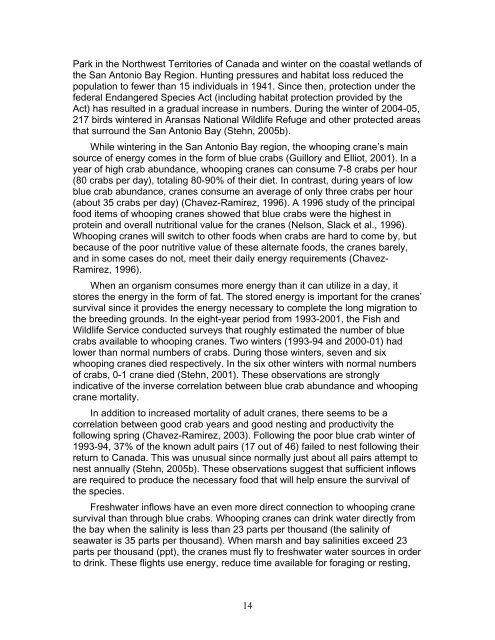The Economic Value of Water and Ecosystem Preservation
The Economic Value of Water and Ecosystem Preservation
The Economic Value of Water and Ecosystem Preservation
You also want an ePaper? Increase the reach of your titles
YUMPU automatically turns print PDFs into web optimized ePapers that Google loves.
Park in the Northwest Territories <strong>of</strong> Canada <strong>and</strong> winter on the coastal wetl<strong>and</strong>s <strong>of</strong><br />
the San Antonio Bay Region. Hunting pressures <strong>and</strong> habitat loss reduced the<br />
population to fewer than 15 individuals in 1941. Since then, protection under the<br />
federal Endangered Species Act (including habitat protection provided by the<br />
Act) has resulted in a gradual increase in numbers. During the winter <strong>of</strong> 2004-05,<br />
217 birds wintered in Aransas National Wildlife Refuge <strong>and</strong> other protected areas<br />
that surround the San Antonio Bay (Stehn, 2005b).<br />
While wintering in the San Antonio Bay region, the whooping crane’s main<br />
source <strong>of</strong> energy comes in the form <strong>of</strong> blue crabs (Guillory <strong>and</strong> Elliot, 2001). In a<br />
year <strong>of</strong> high crab abundance, whooping cranes can consume 7-8 crabs per hour<br />
(80 crabs per day), totaling 80-90% <strong>of</strong> their diet. In contrast, during years <strong>of</strong> low<br />
blue crab abundance, cranes consume an average <strong>of</strong> only three crabs per hour<br />
(about 35 crabs per day) (Chavez-Ramirez, 1996). A 1996 study <strong>of</strong> the principal<br />
food items <strong>of</strong> whooping cranes showed that blue crabs were the highest in<br />
protein <strong>and</strong> overall nutritional value for the cranes (Nelson, Slack et al., 1996).<br />
Whooping cranes will switch to other foods when crabs are hard to come by, but<br />
because <strong>of</strong> the poor nutritive value <strong>of</strong> these alternate foods, the cranes barely,<br />
<strong>and</strong> in some cases do not, meet their daily energy requirements (Chavez-<br />
Ramirez, 1996).<br />
When an organism consumes more energy than it can utilize in a day, it<br />
stores the energy in the form <strong>of</strong> fat. <strong>The</strong> stored energy is important for the cranes’<br />
survival since it provides the energy necessary to complete the long migration to<br />
the breeding grounds. In the eight-year period from 1993-2001, the Fish <strong>and</strong><br />
Wildlife Service conducted surveys that roughly estimated the number <strong>of</strong> blue<br />
crabs available to whooping cranes. Two winters (1993-94 <strong>and</strong> 2000-01) had<br />
lower than normal numbers <strong>of</strong> crabs. During those winters, seven <strong>and</strong> six<br />
whooping cranes died respectively. In the six other winters with normal numbers<br />
<strong>of</strong> crabs, 0-1 crane died (Stehn, 2001). <strong>The</strong>se observations are strongly<br />
indicative <strong>of</strong> the inverse correlation between blue crab abundance <strong>and</strong> whooping<br />
crane mortality.<br />
In addition to increased mortality <strong>of</strong> adult cranes, there seems to be a<br />
correlation between good crab years <strong>and</strong> good nesting <strong>and</strong> productivity the<br />
following spring (Chavez-Ramirez, 2003). Following the poor blue crab winter <strong>of</strong><br />
1993-94, 37% <strong>of</strong> the known adult pairs (17 out <strong>of</strong> 46) failed to nest following their<br />
return to Canada. This was unusual since normally just about all pairs attempt to<br />
nest annually (Stehn, 2005b). <strong>The</strong>se observations suggest that sufficient inflows<br />
are required to produce the necessary food that will help ensure the survival <strong>of</strong><br />
the species.<br />
Freshwater inflows have an even more direct connection to whooping crane<br />
survival than through blue crabs. Whooping cranes can drink water directly from<br />
the bay when the salinity is less than 23 parts per thous<strong>and</strong> (the salinity <strong>of</strong><br />
seawater is 35 parts per thous<strong>and</strong>). When marsh <strong>and</strong> bay salinities exceed 23<br />
parts per thous<strong>and</strong> (ppt), the cranes must fly to freshwater water sources in order<br />
to drink. <strong>The</strong>se flights use energy, reduce time available for foraging or resting,<br />
14
















